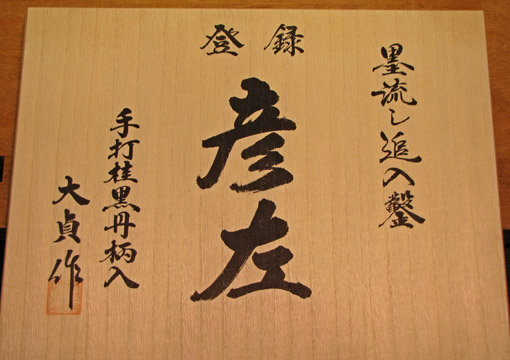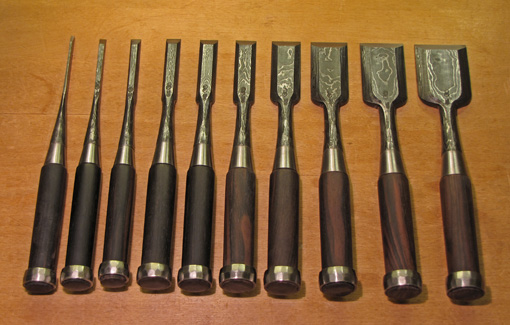I have been using this set of chisels for two years now as the primary chisels in my shop, mostly for chopping joinery but also for many general chiseling and paring tasks. They are beautiful. “Blue paper” steel has been laminated to the soft steel body which has been repeatedly folded to produce a wood grain pattern (mokume). While it was not easy to part with the money to buy them, they have been well worth it.
These chisels, with the exception of the handles, were made in the hands of one man, Teiichirou Ohkubo, who uses the market name “Daitei,” in his very small shop in Yoita, Niigata, Japan. (Spellings of his name vary among Western sources.) He works at a forge established about 100 years ago by his grandfather. I am inspired working with these chisels because, though I will likely never meet Mr. Ohkubo, I sense a personal connection with a craftsman putting some of his spirit into his product which, in turn, assists me in doing the same. That’s a good feeling.
The handmade inscription on the box in the photo below reads, I am told, “made by Dai Tei,” in the lower left corner, above the red personal mark (chop).

Now for the best part. They have been easy to sharpen on Shapton stones and hold an edge magnificently. I use a primary bevel of 27.5 degrees and a secondary bevel of 32.5 degrees. This gives excellent penetration and completely avoids chipping of the edges. Sometimes, just for curiosity, I’ll pause fairly well along in chopping some joints and am amazed to see the chisels can still shave hair on my arm.
They have an authoritative weight and balance in the hand. I have long enjoyed the ergonomics of Japanese chisels though I recognize this is a matter of personal preference. I believe the handles are Macassar ebony, contrary to the vendor’s description. Initially, I had some concerns regarding the handle wood being perhaps too brittle and prone to splitting. I properly set the hoops (I like Joel Moskowitz’ excellent step by step method), and, despite some serious working action with a mallet, have had no problems.
Any imperfections? Yes, of course, but not enough to cause practical problems. The handle on one of the smaller chisels is undersized and there is slight inconsistency in the angles of the side bevels among some of the smaller chisels.
It is exciting and motivating to work with personally made woodworking tools. Woodworkers now are fortunate to have this kind of tool available from not only Japanese makers, but, more than ever in my lifetime, from many outstanding Western toolmakers. By all means, seek out and use some of these personal tools for personal woodworking.



Hey Rob,
Where did you purchase these chisels? They look amazing.
Tico
Tico,
They are available from So Yamoshita at http://www.japan-tool.com/
And from Dieter Schmid at http://www.fine-tools.com/ which is where I got them without realizing at the time that So also sells them.
I would like to put in a pitch (unsolicited, uncompensated) for So, who is exceptionally knowledgeable, very generous with sharing his knowledge, and has been a pleasure to deal with.
Rob
Rob these chisels look amazing. I especially like the handles. Could I ask for some rough dimensions of them? Diameter and length?
Tom,
Typical of Japanese bench chisels, approximate dimensions are 8 1/2″ in overall length with 2 3/8″ long blades. The blade widths in this set are from 3mm (1/8″) to 42mm (1 5/8″).
Each handle measures about 3 5/8″ from its end to its entrance into the socket. The handles are slightly barrel-shaped and range in their widest diameters from about 3/4″ to 29/32″.
I hope this helps. Thanks for reading, Tom.
Rob
By the way, here is a link where So describes how to set up a new Japanese chisel: http://www.woodworkforums.com/f111/how-set-up-brand-new-chisel-47840/
Rob
Thanks Rob. I actually just happened upon a vintage set of Rockford Greenlee socket chisels that have very tired handles. I thought these handles looked just the ticket to replace them. I know it’ll be a mis-mash of cultures, but we should embrace that, right? ;)
Love the blog BTW, keep it up.
Given the precision of the angles you mentioned, I assume you use a honing guide. If so, which one?
Also, I’m curious how fine a grit you hone to.
Thanks!
Hi Carl,
Here’s a post about the shop-made angle guides that I use:
http://www.rpwoodwork.com/blog/2008/10/28/honing-guides/
This system has worked well for me for many years.
The 32.5 and 27.5 angles are used, as opposed to whole numbers, just because they’re half way between the multiples of 5.
Lately, I’ve been trying the Sharp Skate II guide but I don’t have enough experience with it to give a reliable assessment.
For bench chisels, I finish with a Shapton 15000, going to it directly from the 5000. In the Shapton glass stones, to 16K from the 4K.
Thanks for reading,
Rob
Rob,
I suggest you try using a Japanese hammer on the chisels as that was what they were meant to be hit with (the hoops are fashioned to not slide down on the handles when hit) and I believe you will find as I have that you will deliver more power to each hit as the hammer does not bounce like the wooden mallet will. I’ve used my Japanese chisels for over 30 years now and have never hit then with anything except my steel hammers.
By the way those are about the most beautiful set of chisels I have ever seen.
Charlie,
Thanks for the comments.
I currently use and very much like a 14 ounce Glen-Drake Tite Hammer which has a brass head. In the past I have used a classic wooden joiner’s mallet made of a dense wood. It did not bounce.
While I agree a metal hammer delivers more power to the wooden handle of a Japanese chisel, and metal hammers are “correct” and traditional with Japanese chisels, power is not the only criterion and some woodworkers may prefer a wooden mallet. In 25 years of using and tuning Japanese chisels, I have found a wooden mallet works and has its own merits.
Rob